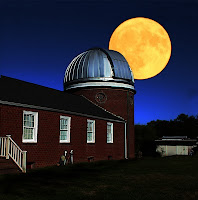Our annual light pollution campaign, GLOBE at Night (GAN) is underway! Help us make a worldwide map of light pollution by contributing your observations and recruiting others to participate.
I know many of you have participated in the AFGU Dark Skies sessions in the past and may be veterans of GLOBE at Night. For the newcomers, it is fun and easy to get involved. You make measurements of the brighteness of the night sky by observing the constellation of Orion (late February or early March) or Leo (late March/early April) and compare your observation to the magnitude charts that are online. Enter your data along with your latitude, longitude, time and date of the observations on the reports page. You can enter more than one data point and we would love to see you make lots of observations from different locations! Visit the GLOBE at Night website for full details.
There are a couple of new additions for 2011.
1. Two campaigns! GAN has expanded. Observations can be made from February 22nd to March 6th and from March 22nd to April 4th (northern hemisphere) or March 24th to April 6th (southern hemisphere). The second set of campaigns will use the constellations of Leo and Crux instead of Orion.
2. You can do GLOBE at Night on your cellphone this year! The new reports page works on cell phones. It will even read your GPS coordinates, date and time of the observation directly from your cell phone's GPS and fill in those parts of the form for you. To top it off, there is even a night mode that will make the screen red to preserve your night vision.
3. New Dark Skies Rangers activities! The Dark Skies Rangers program consists of a series of activities on different aspects of light pollution suitable for a variety of different audiences. They are great additions to dark sky programs.
4. Expanded social media presence. You can follow GLOBE at Night on Twitter or Facebook to keep up with the latest news.
I hope you can join us for this exciting project. If you have access to lists/blogs/discussion forums/twitter feeds where you can help spread the word, we would appreciate your help. Connie Walker, the GLOBE at Night director, sent a couple of versions of an ad you can use for promotional purposes. I am attaching them below.
Thanks for all you do. Help us top last year's 15,000 observations!
I know many of you have participated in the AFGU Dark Skies sessions in the past and may be veterans of GLOBE at Night. For the newcomers, it is fun and easy to get involved. You make measurements of the brighteness of the night sky by observing the constellation of Orion (late February or early March) or Leo (late March/early April) and compare your observation to the magnitude charts that are online. Enter your data along with your latitude, longitude, time and date of the observations on the reports page. You can enter more than one data point and we would love to see you make lots of observations from different locations! Visit the GLOBE at Night website for full details.
There are a couple of new additions for 2011.
1. Two campaigns! GAN has expanded. Observations can be made from February 22nd to March 6th and from March 22nd to April 4th (northern hemisphere) or March 24th to April 6th (southern hemisphere). The second set of campaigns will use the constellations of Leo and Crux instead of Orion.
2. You can do GLOBE at Night on your cellphone this year! The new reports page works on cell phones. It will even read your GPS coordinates, date and time of the observation directly from your cell phone's GPS and fill in those parts of the form for you. To top it off, there is even a night mode that will make the screen red to preserve your night vision.
3. New Dark Skies Rangers activities! The Dark Skies Rangers program consists of a series of activities on different aspects of light pollution suitable for a variety of different audiences. They are great additions to dark sky programs.
4. Expanded social media presence. You can follow GLOBE at Night on Twitter or Facebook to keep up with the latest news.
I hope you can join us for this exciting project. If you have access to lists/blogs/discussion forums/twitter feeds where you can help spread the word, we would appreciate your help. Connie Walker, the GLOBE at Night director, sent a couple of versions of an ad you can use for promotional purposes. I am attaching them below.
Thanks for all you do. Help us top last year's 15,000 observations!











